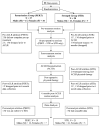Unilateral stance strategies of athletes with ACL deficiency
- PMID: 22983931
- PMCID: PMC3610327
- DOI: 10.1123/jab.28.4.374
Unilateral stance strategies of athletes with ACL deficiency
Abstract
Aberrant movement strategies are characteristic of ACL-deficient athletes with recurrent knee instability (noncopers), and may instigate premature or accelerate joint degradation. Biomechanical evaluation of kinematic changes over time may elucidate noncopers' responses to neuromuscular intervention and ACL reconstruction (ACLR). Forty noncopers were randomized into a perturbation group or a strength training only group. We evaluated the effects of perturbation training, and then gender on knee angle and tibial position during a unilateral standing task before and after ACLR. No statistically significant interactions were found. Before surgery, the strength training only group demonstrated knee angle asymmetry, but 6 months after ACLR, both groups presented with similar knee flexion between limbs. Aberrant and asymmetrical tibial position was found only in females following injury and ACLR. Neither treatment group showed distinct unilateral standing strategies following intervention; however, males and female noncopers appear to respond uniquely to physical therapy and surgery.
Figures





Similar articles
-
Report of the Primary Outcomes for Gait Mechanics in Men of the ACL-SPORTS Trial: Secondary Prevention With and Without Perturbation Training Does Not Restore Gait Symmetry in Men 1 or 2 Years After ACL Reconstruction.Clin Orthop Relat Res. 2017 Oct;475(10):2513-2522. doi: 10.1007/s11999-017-5279-8. Clin Orthop Relat Res. 2017. PMID: 28224442 Free PMC article. Clinical Trial.
-
Report of the Clinical and Functional Primary Outcomes in Men of the ACL-SPORTS Trial: Similar Outcomes in Men Receiving Secondary Prevention With and Without Perturbation Training 1 and 2 Years After ACL Reconstruction.Clin Orthop Relat Res. 2017 Oct;475(10):2523-2534. doi: 10.1007/s11999-017-5280-2. Clin Orthop Relat Res. 2017. PMID: 28224443 Free PMC article. Clinical Trial.
-
[Postural control strategy in patients with anterior cruciate ligament deficiency].Chir Narzadow Ruchu Ortop Pol. 2009 Nov-Dec;74(6):353-60. Chir Narzadow Ruchu Ortop Pol. 2009. PMID: 20201334 Polish.
-
Identifying individuals with an anterior cruciate ligament-deficient knee as copers and noncopers: a narrative literature review.J Orthop Sports Phys Ther. 2011 Oct;41(10):758-66. doi: 10.2519/jospt.2011.3384. Epub 2011 Sep 30. J Orthop Sports Phys Ther. 2011. PMID: 21979555 Review.
-
Progressive Changes in Walking Kinematics and Kinetics After Anterior Cruciate Ligament Injury and Reconstruction: A Review and Meta-Analysis.J Athl Train. 2017 Sep;52(9):847-860. doi: 10.4085/1062-6050-52.6.06. J Athl Train. 2017. PMID: 28985125 Free PMC article. Review.
Cited by
-
Operative and nonoperative management of anterior cruciate ligament injury: Differences in gait biomechanics at 5 years.J Orthop Res. 2020 Dec;38(12):2675-2684. doi: 10.1002/jor.24652. Epub 2020 Mar 20. J Orthop Res. 2020. PMID: 32159239 Free PMC article.
-
Gait mechanics and tibiofemoral loading in men of the ACL-SPORTS randomized control trial.J Orthop Res. 2018 Sep;36(9):2364-2372. doi: 10.1002/jor.23895. Epub 2018 Apr 24. J Orthop Res. 2018. PMID: 29575090 Free PMC article. Clinical Trial.
-
Sex-specific gait adaptations prior to and up to 6 months after anterior cruciate ligament reconstruction.J Orthop Sports Phys Ther. 2015 Mar;45(3):207-14. doi: 10.2519/jospt.2015.5062. Epub 2015 Jan 27. J Orthop Sports Phys Ther. 2015. PMID: 25627155 Free PMC article.
-
Safety and Effectiveness of a Perturbation-based Neuromuscular Training Program on Dynamic Balance in Adolescent Females: A Randomized Controlled Trial.Int J Sports Phys Ther. 2021 Aug 1;16(4):1001-1015. doi: 10.26603/001c.25685. eCollection 2021. Int J Sports Phys Ther. 2021. PMID: 34386279 Free PMC article.
-
High muscle co-contraction does not result in high joint forces during gait in anterior cruciate ligament deficient knees.J Orthop Res. 2019 Jan;37(1):104-112. doi: 10.1002/jor.24141. Epub 2018 Oct 9. J Orthop Res. 2019. PMID: 30230006 Free PMC article.
References
Publication types
MeSH terms
Grants and funding
LinkOut - more resources
Full Text Sources
Medical

